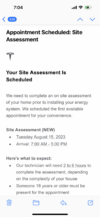I am investigating back up power for my home in Pennsylvania after installing a 15.33 kW SunPower array last year.
I come to this post without a reasonable understanding of the technology but learned a great deal over the weekend after posting about compatibility of SunPower with Powerwall.
I am communicating with a Tesla approved installer with solid Google reviews who just quoted $46k for 3 Powerwalls (Tesla quoted $33k with install per screen shot below).
Installer appears to be nudging me toward Sol-Ark, which appears to be good option since I would like to preserve ability to add a generator.
I’m wondering what someone more knowledgeable thinks about the installers pricing pitch. My concern is that if the quote for Powerwalls is unreasonably high, is the quote for Sol-Ark also unreasonably high.
The pricing quotes are as follows:
“We can install 2 Tesla PowerWalls for $31,495.
This would provide you with 27 kWh of storage.
If you wanted a 3rd Powerwall, for a total of 40 kWh of storage, then you would be looking at a cost of $45,995
One big thing here is to make sure that you have enough wall space available inside, near your main panel for the powerwall.
If you are interested in other options, we can set you up with a Solark/Homegrid system. This system comes with a SolArk 15 kW Inverter and Homegrid Batteries ranging from 10 kWh of storage up to 40+ kWh of storage. With this system you have a bit more flexibility in terms of battery size, as well as adding batteries in the future.
15 kW SolArk with 10 kWh of storage would be your minimal entry point for a cost of $22,500. We can add 5 kWh increments of storage for $4,000 a piece.
The other nice feature with this system is that it has an input for an external generator as well.“
I come to this post without a reasonable understanding of the technology but learned a great deal over the weekend after posting about compatibility of SunPower with Powerwall.
I am communicating with a Tesla approved installer with solid Google reviews who just quoted $46k for 3 Powerwalls (Tesla quoted $33k with install per screen shot below).
Installer appears to be nudging me toward Sol-Ark, which appears to be good option since I would like to preserve ability to add a generator.
I’m wondering what someone more knowledgeable thinks about the installers pricing pitch. My concern is that if the quote for Powerwalls is unreasonably high, is the quote for Sol-Ark also unreasonably high.
The pricing quotes are as follows:
“We can install 2 Tesla PowerWalls for $31,495.
This would provide you with 27 kWh of storage.
If you wanted a 3rd Powerwall, for a total of 40 kWh of storage, then you would be looking at a cost of $45,995
One big thing here is to make sure that you have enough wall space available inside, near your main panel for the powerwall.
If you are interested in other options, we can set you up with a Solark/Homegrid system. This system comes with a SolArk 15 kW Inverter and Homegrid Batteries ranging from 10 kWh of storage up to 40+ kWh of storage. With this system you have a bit more flexibility in terms of battery size, as well as adding batteries in the future.
15 kW SolArk with 10 kWh of storage would be your minimal entry point for a cost of $22,500. We can add 5 kWh increments of storage for $4,000 a piece.
The other nice feature with this system is that it has an input for an external generator as well.“








